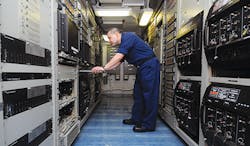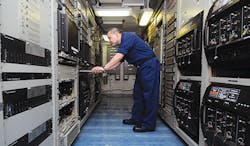GD upgrading Navy shipboard radio with HF automatic link establishment
SAN DIEGO - Military radio experts at General Dynamics are upgrading the U.S. Navy AN/USC-61(C) maritime radio system to high-frequency (HF) capability and automatic link establish- ment (ALE) to enhance shipboard over-the-horizon communications.
U.S. Space and Naval Warfare Systems Command (SPAWAR) officials in San Diego announced a $7.3 million contract modification to General Dynamics Mission Systems in Scottsdale, Ariz., to update DMR software to add HF and ALE capabilities.
The General Dynamics AN/USC-61(C) shipboard radio enables surface ships and submarines to communicate over high frequency (HF), ultra-high frequency (UHF) line of sight, UHF satellite communications (SATCOM), and very high frequency (VHF) radio bands. HF radio operates on frequencies between 3 and 30 MHz using radio waves that can bounce off the ionosphere layer of the Earth's atmosphere to achieve long-range communications. HF also is capable of line-of-sight communications, as well as ground-wave over-the-horizon communications.
Using HF can be tricky because changes in the ionosphere can cause RF interference and communications dropouts. It also is susceptible to interference from lightning storms, and propagates differently in the daytime, at night, and during different seasons.
Automatic link establishment seeks to overcome deficiencies by enabling radio operators to choose the best frequencies on which two stations or a network of stations can transmit and receive. ALE is the de-facto worldwide standard for initiating and sustaining HF communications for voice, data, text, instant messaging, internet messaging, or image communications. ALE alerts radio operators audibly and visually so they can begin communicating with each other immediately, and helps eliminate the longstanding need for repetitive calling on pre-determined time schedules and monitoring static on HF radios.
An ALE-equipped radio uses a callsign or address in an ALE controller, which scans through a list of frequencies listening for other ALE radio callsigns. To reach a specific station, the caller simply enters the callsign just like dialing a phone number.
The ALE controller selects the best available frequency and sends out brief digital selective calling signals containing the callsigns. When the distant scanning station detects the first few characters of its callsign, it stops scanning and stays on that frequency. The two stations' ALE controllers automatically handshake to confirm that a link is established and they are ready to communicate. If changes in the ionosphere break or interfere with communications in progress, the system quickly can re-establish communications by finding other clear frequencies.
AN/USC-61(C) uses open-architecture standards and includes embedded type 1 encryption; embedded red/black baseband switching and routing; co-site performance; single point of control for radio communications; and built-in test (BIT).
General Dynamics will do the work in Scottsdale, Ariz., and should be finished by April 2018.

